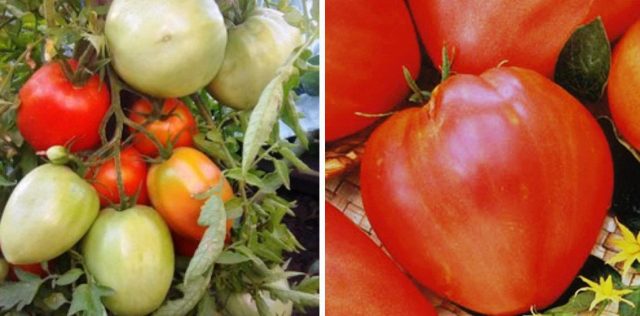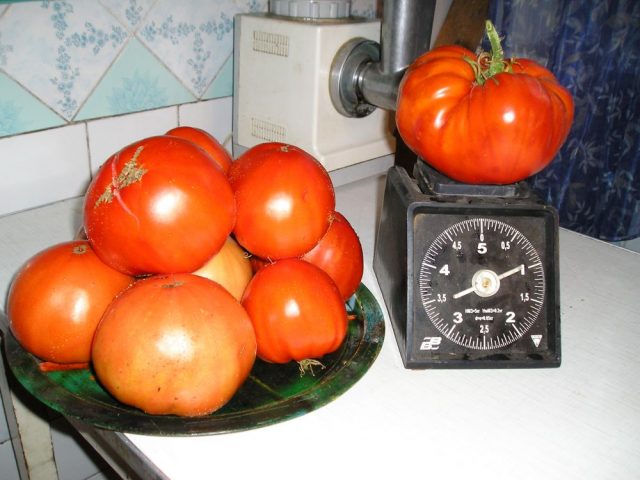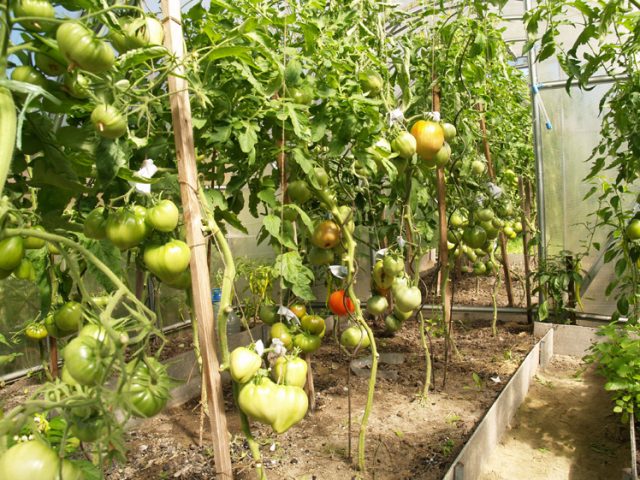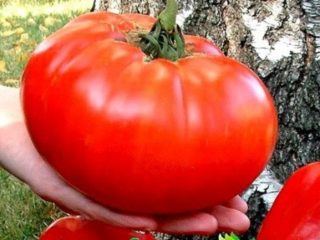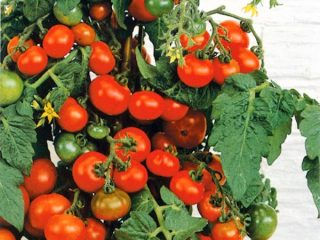Content
The Sugar Giant tomato is the result of amateur selection, which appeared on the Russian market more than 10 years ago. The variety was not registered in the State Register, which creates difficulties in accurately determining its characteristics, but this does not prevent the crop from being in demand among lovers of large, sweet tomatoes. According to reviews from gardeners who have been cultivating tomatoes for many years, the Sugar Giant is undemanding in care, is resistant to weather changes and sets excellent fruit, regardless of the climate.
Description of the tomato variety Sugar Giant
The description of the variety is based on reviews from amateur vegetable growers, since there is no such tomato in the plant register of Russia, Belarus and Ukraine. However, Sugar Giant seeds are offered by several seed companies. The description, photo and characteristics of the variety from different manufacturers may differ slightly.
In various sources, the tomato is described as a vegetable of a cuboid, oblong or spherical-flattened shape. Experienced amateur agronomists claim that the characteristic shape of the fruits of this variety is round, slightly pointed and elongated towards the tip (heart-shaped).
Otherwise, the description of the Sugar Giant tomato has no discrepancies. The tomato bush develops according to the indeterminate type, without stopping the growth of the central stem. In open ground, the crop can reach a height of 2 meters, in a greenhouse - 1.5 m.
Tomato shoots are thin but strong. The foliage is average. The growth of side shoots is moderate. Drooping dark green leaves provide the bushes with good ventilation and light.
The first flower raceme appears above the 9th leaf, then regularly through 2 internodes. The ovaries are formed abundantly until frost. Each cluster lays up to 6 fruits.
The fruiting period of the Sugar giant is extended and is limited only by the onset of frost. Tomatoes are classified as medium-late, the first ripe fruits are obtained 120-125 days after germination. The warmer the growing region, the earlier the first tomatoes ripen. In the open ground of southern Russia, the harvest begins in 100-110 days.
The tall, thin stem bears many weighty fruits. Therefore, the garter procedure is mandatory at all stages of cultivation. Especially large tomato clusters require special support.
Brief description and taste of the fruit
Heart-shaped, large tomatoes of the Sugar Giant variety when unripe have a soft green color with a dark spot around the stalk. When ripe, tomatoes acquire a uniform red, classic color.The pulp is completely colored in the same tone and does not have a hard core.
Varietal characteristics of Sugar Giant tomatoes:
- the pulp is dense, juicy: dry matter no more than 5%;
- the peel is thin, which is why transportability is low;
- the content of sugars and lycopene (a carotenoid pigment) is above average for tomatoes;
- the average weight of the fruit is 300 g, the maximum is 800 g (achieved in open beds).
Cracking of ripe tomatoes most often occurs in open ground conditions, due to waterlogging during the ripening of tomatoes. Greenhouse and greenhouse fruits of the Sweet Giant are not prone to peel rupture.
High taste and juicy pulp make it possible to process tomatoes for juice and sauces. Whole-fruit preservation is impossible due to the large size of ripe fruits. Tomatoes are mainly consumed fresh and for salads.
The taste characteristics of the Sugar Giant are rated as excellent. The aroma and sugar content decrease only during a cloudy, rainy season. Such factors do not affect the size of tomatoes and overall yield.
Varietal characteristics
The characteristics of the Sugar Giant tomato and the description of the variety are constantly being updated based on reviews from amateur vegetable growers from all over the country. The timing of fruiting varies significantly from region to region and depends on climatic conditions. In protected ground, the fruit production period of the Sugar Giant is especially extended and can exceed 2 months.
The overall yield of the variety greatly depends on the method of formation.When growing in two stems, the tops of the shoots are pinched, leaving 2 leaves above the bunch, at a height of 1.5 m. In greenhouses, the Sugar Giant is formed into one sleeve, leaving one stepson for replacement and prolongation of fruiting.
From one bush, under the most unfavorable conditions, you can get at least 4 kg of tomatoes. Proper agricultural technology increases productivity up to 6-7 kg. When planted at a density of 3 plants per 1 sq. m you can expect a total fruit yield of up to 18 kg.
The Sugar Giant's immunity to diseases has not been reliably confirmed. Under different growing conditions and climates, tomatoes react differently to infections.
General information about the resistance of the Sugar giant to typical tomato diseases:
- Late ripening dates coincide with the period of late blight activity. It is recommended to carry out preventive spraying with Bordeaux mixture or other copper-containing preparations.
- The variety exhibits relative resistance to fungi. To prevent diseases, plantings should not be overly moistened. Most often, infection occurs in high humidity and cold soil.
- To prevent blossom end rot, calcium is added to the soil (in the form of ground chalk, slaked lime).
- The resistance of the Sugar giant to the causative agent of tobacco mosaic, Alternaria, is noted.
Cracking of fruits during ripening is not a distinctive feature of the variety. This phenomenon is observed in large varieties with thin skins with unbalanced watering. To prevent cracking, enrich the soil with saltpeter and reduce watering during fruiting.
Sugar giant tomato bushes are just as susceptible to insect damage as all nightshades.If pests are detected, the plantings will have to be treated with a specially selected insecticide or a complex preparation.
Pros and cons of the variety
Experienced gardeners, sharing their experience in growing the Sugar Giant, note the following advantages of the variety:
- Sweet pulp, strong tomato aroma of fruit.
- Possibility to obtain ripe tomatoes for a long time.
- Drooping foliage that does not block the fruit from the sun.
- Possibility of propagation by own seeds.
- The variety does not require watering.
Negative reviews are most often associated with the discrepancy between the grown fruits and the declared variety. Various manufacturers place on the packaging of Sugar Giant seeds photographs of tomatoes that differ greatly from each other in shape and even color. It is better to purchase planting material from private nurseries with a proven reputation.
A relative disadvantage of tomatoes is the thinness of the stems, which require good support. You should ensure that the bush is securely attached and the clusters are supported throughout the entire growing season.
Rules for planting and care
In unprotected soil, the Sugar Giant will show its full potential only in the south of the country. In more temperate climates, most of the crop may not have time to reach full ripeness.
In the middle zone, the tomato bushes are lower, the fruits are smaller, but with sufficient lighting, the taste of the tomatoes does not suffer from this. In such regions, the variety is grown under film covers. In cold climates, it is possible to obtain good yields of the Sugar Giant only in greenhouse conditions.
Growing seedlings
The timing of sowing the Sugar Giant variety for seedlings is calculated so that the young plants are ready for removal to a permanent place after 70 days. When sown in March, transplanting seedlings will be possible from mid-May. If determinate tomatoes can be grown in one large container in rows, then for tall tomatoes it is necessary to prepare separate glasses for transplanting after picking.
The variety has no special requirements for the composition and nutritional value of the soil; it is important that the soil is loose and breathable. A ready-made store-bought soil mixture for nightshades is quite sufficient. Mixtures made independently from peat, garden soil and sand must be disinfected before planting, for example, by heating them in the oven.
Planting material collected with one's own hands requires disinfection in a solution of potassium permanganate, Epin or Fitosporin. The seeds are kept in the solution for at least 0.5 hours, and then dried until they flow.
Stages of growing Sugar Giant seedlings:
- The soil mixture is laid out in containers and the seeds are immersed in it to a depth of no more than 1.5 cm, retreating about 2 cm each time.
- Spray the soil with a spray bottle for uniform, moderate moisture.
- Cover the containers with glass or polyethylene for a greenhouse effect.
- Keep plantings at a temperature of about + 25 ° C until germination.
- Remove the cover and grow the seedlings in the light.
To prevent the appearance of blackleg, the sprouts can be pollinated with ash after each watering. Moistening is carried out no earlier than the soil dries to a depth of 1 cm.
After two true leaves appear, Sugar Giant tomatoes should be pruned. The plant is carefully removed from the ground and the root is shortened by 1/3. At this point, you can transplant the plants one at a time into deep glasses with a capacity of at least 300 ml. Picking will force the tap root system to develop in width.
To prevent seedlings from stretching out excessively, they should be provided with good lighting. The best temperature for the development of tomatoes is from 16 to 18 °C.
Transplanting seedlings
Young Sugar Giant bushes are transplanted into open ground or a greenhouse after the soil has warmed to + 10 °C in the absence of night frosts. Typically for the middle zone this is the period from mid-May to early June.
Before starting work, you should prepare both the soil and tomato sprouts:
- the soil in the garden is cleared of weed, dig up and fertilize with humus, lime if necessary;
- planting holes are prepared slightly larger than glasses, they are disinfected with a solution of potassium permanganate, and a little humus, peat, and wood ash are added;
- at least 20 days before transplanting, watering is reduced, and 7 days the moisture is completely stopped, so it will be easier to move the seedlings without damage and the plants will rapidly begin to grow in the new place;
- young tomatoes begin to be taken out into the open air 10-14 days before transplantation for hardening;
- Sugar giant seedlings are ready for planting at the age of 60 days, with a height of more than 20 cm, with 6 true leaves.
The planting scheme suggests leaving 60 cm between the Sugar Giant bushes. Typically, tomatoes of this variety are placed in two lines with a 50 cm indent. About 80 cm are measured between the rows. As a result, there should be no more than 3 tomatoes per square meter.
When planting, the Sugar Giant seedlings are buried down to the first leaves. If the bushes are overgrown or elongated, the stem is immersed even deeper or placed obliquely in the hole.
Planting care
The Sugar Giant tomato variety tolerates dry soil well. Excessive moisture is much more dangerous for it. For normal development of tomatoes, watering once a week is enough, but not less than 10 liters per bush. Reduce irrigation before flowering and before the final ripening of the next bunch.
Tomatoes of the Sugar Giant variety are responsive to fertilizing. You can fertilize the plantings every 2 weeks: first with diluted manure, and after flowering - with potassium salt and superphosphate.
In the open ground of warm regions, the Sugar Giant bush can be formed into 2 or 3 stems. All lateral shoots and stepsons should be removed regularly. It is better to grow greenhouse and greenhouse tomatoes with one stem.
Conclusion
The Sugar Giant tomato, being a “folk” variety, is very popular among summer residents due to its undemanding nature when it comes to watering. Grooming once every few weeks is enough to get a decent harvest. The variety develops well in a greenhouse, hotbed or open garden bed and is able to delight with sweet, large tomatoes until frost.
